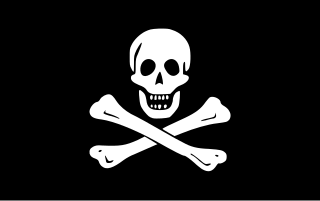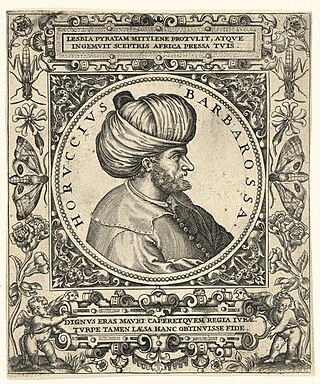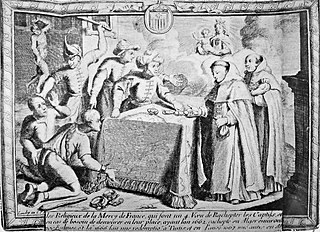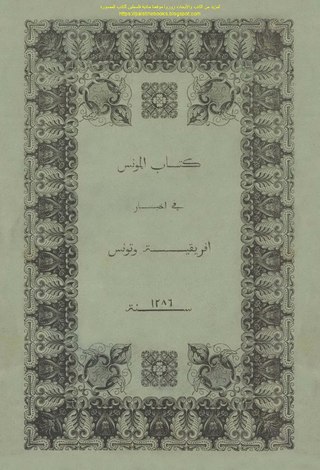Related Research Articles

Piracy is an act of robbery or criminal violence by ship or boat-borne attackers upon another ship or a coastal area, typically with the goal of stealing cargo and other valuable goods. Those who conduct acts of piracy are called pirates, and vessels used for piracy are called pirate ships. The earliest documented instances of piracy were in the 14th century BC, when the Sea Peoples, a group of ocean raiders, attacked the ships of the Aegean and Mediterranean civilisations. Narrow channels which funnel shipping into predictable routes have long created opportunities for piracy, as well as for privateering and commerce raiding.

A privateer is a private person or vessel which engages in maritime warfare under a commission of war. Since robbery under arms was a common aspect of seaborne trade, until the early 19th century all merchant ships carried arms. A sovereign or delegated authority issued commissions, also referred to as letters of marque, during wartime. The commission empowered the holder to carry on all forms of hostility permissible at sea by the usages of war. This included attacking foreign vessels and taking them as prizes and taking crews prisoner for exchange. Captured ships were subject to condemnation and sale under prize law, with the proceeds divided by percentage between the privateer's sponsors, shipowners, captains and crew. A percentage share usually went to the issuer of the commission.

The Barbary pirates, Barbary corsairs, or Ottoman corsairs were mainly Muslim pirates and privateers who operated from the Barbary states. This area was known in Europe as the Barbary Coast, in reference to the Berbers. Slaves in Barbary could be of many ethnicities, and of many different religions, such as Christian, Jewish, or Muslim. Their predation extended throughout the Mediterranean, south along West Africa's Atlantic seaboard and into the North Atlantic as far north as Iceland, but they primarily operated in the western Mediterranean. In addition to seizing merchant ships, they engaged in razzias, raids on European coastal towns and villages, mainly in Italy, France, Spain, and Portugal, but also in the British Isles, the Netherlands, and Iceland.
Murat Reis the Elder was an Ottoman privateer and admiral, who served in the Ottoman Navy. He is regarded as one of the most important Barbary corsairs.

Occhiali was an Italian farmer, then Ottoman privateer and admiral, who later became beylerbey of the Regency of Algiers, and finally Grand Admiral of the Ottoman fleet in the 16th century.

Aruj Barbarossa, known as Oruç Reis to the Turks, was an Ottoman corsair who became Sultan of Algiers. The elder brother of the famous Ottoman admiral Hayreddin Barbarossa, he was born on the Ottoman island of Midilli and died in battle against the Spanish at Tlemcen.

The Golden Age of Piracy is a common designation for the period between the 1650s and the 1730s, when maritime piracy was a significant factor in the histories of the North Atlantic and Indian Oceans.

Hayreddin Barbarossa, also known as Hayreddin Pasha, Hızır Hayrettin Pasha, and simply Hızır Reis, was an Ottoman corsair and later admiral of the Ottoman Navy. Barbarossa's naval victories secured Ottoman dominance over the Mediterranean during the mid-16th century.
Kemal Reis was an Ottoman privateer and admiral. He was also the paternal uncle of the famous Ottoman admiral and cartographer Piri Reis, who accompanied him in most of his important naval expeditions.
Jan Janszoon van Haarlem, commonly known as Reis Mourad the Younger, was a Dutch pirate who later became a Barbary corsair in Ottoman Algeria and the Republic of Salé. After being captured by Algerian corsairs off Lanzarote in 1618, he converted to Islam and changed his name to Mourad. He became one of the most famous of the 17th-century Barbary corsairs. Together with other corsairs, he helped establish the independent Republic of Salé at the city of that name, serving as the first President and Commander. He also served as Governor of Oualidia.
Kurtoğlu Muslihiddin Reis was the admiral of the Ottoman Empire, as well as the Sanjak Bey of Rhodes. He played an important role in the Ottoman conquests of Egypt (1517) and Rhodes (1522) during which he commanded the Ottoman naval forces. He also helped establish the Ottoman Indian Ocean Fleet based in Suez, which was later commanded by his son, Kurtoğlu Hızır Reis.
Salah Rais was the 7th King of Algiers, an Ottoman privateer and admiral. He is alternatively referred to as Sala Reis, Salih Rais, Salek Rais and Cale Arraez in several European sources, particularly in Spain, France and Italy.
This timeline of the history of piracy in the 1630s is a chronological list of key events involving pirates between 1630 and 1639.

The Barbary slave trade, part of the Arab slave trade, involved the capture and selling of European slaves at slave markets in the Barbary states. European slaves were captured by Barbary pirates in slave raids on ships and by raids on coastal towns from Italy to the Netherlands, Ireland and the southwest of Britain, as far north as Iceland and into the Eastern Mediterranean.

Siemen Danziger, better known by his anglicized names Zymen Danseker and Simon de Danser, was a 17th-century Dutch privateer and Barbary corsair based in Ottoman Algeria. His name is also written Danziker, Dansker, Dansa or Danser.

The Republic of Salé, also known as the Bou Regreg Republic and the Republic of the Two Banks, was a city-state maritime corsair republic based at Salé in Morocco during the 17th century, located at the mouth of the Bou Regreg river. It was founded by Moriscos from the town of Hornachos, in western Spain. The Moriscos were the descendants of Muslims who were nominally converted to Christianity, and were subject to mass deportation during Philip III's reign, following the expulsion of the Moriscos decrees. The republic's main commercial activities were the Barbary slave trade and piracy during its brief existence in the 17th century.

Anglo-Turkish piracy or the Anglo-Barbary piracy was the collaboration between Barbary pirates and English pirates against Catholic shipping during the 17th century.
Jewish pirates were seafaring Jewish people who engaged in piracy. While there is some mention of the phenomenon in antiquity, especially during the Hasmonean period, most Jewish pirates were Sephardim who operated in the years following the Alhambra Decree ordering the expulsion of Iberia's Jews. Upon fleeing Spain and Portugal, some of these Jews became pirates and turned to attacking the Catholic Empire's shipping as both Barbary corsairs from their refuge in the Ottoman dominions, as well as privateers bearing letters of marque from Spanish rivals such as the United Netherlands.

Dragut was an Ottoman corsair, naval commander, governor, and noble. Under his command, the Ottoman Empire's maritime power was extended across North Africa. Recognized for his military genius, and as being among "the most dangerous" of corsairs, Dragut has been referred to as "the greatest pirate warrior of all time", "undoubtedly the most able of all the Turkish leaders", and "the uncrowned king of the Mediterranean". He was nicknamed "the Drawn Sword of Islam". He was described by a French admiral as "a living chart of the Mediterranean, skillful enough on land to be compared to the finest generals of the time" and that "no one was more worthy than he to bear the name of king". Hayreddin Barbarossa, who was his mentor, stated that Dragut was ahead of him "both in fishing and bravery".

The ta'ifa of raïs or the Raïs for short, were Barbary pirates based in Ottoman Algeria who were involved in piracy and the slave trade in the Mediterranean Sea from the 16th to the 19th century. They were an ethnically mixed group of seafarers, including mostly "renegades" from European provinces of the Mediterranean and the North Sea, along with a minority of Turks and Moors. Such crews were experienced in naval combat, making Algiers a formidable pirate base. Its activity was directed against the Spanish empire, but it did not neglect the coasts of Sicily, Sardinia, Naples or Provence. It was the taifa which, through its seizures, maintained the prosperity of Algiers and its finances.
References
- ↑ Frijhoff, Willem and Marijke Spies. Dutch Culture in a European Perspective. Basingstoke, UK: Palgrave Macmillan, 2004. (pg. 29) ISBN 90-232-3963-6
- 1 2 3 4 5 6 7 8 9 10 11 12 13 14 15 16 17 18 Rogozinski, Jan (1995). The Wordsworth Dictionary of Pirates. Hertfordshire: Wordsworth Editions. ISBN 1-85326-384-2.
- ↑ Lane, Kris E. Pillaging the Empire: Piracy in the Americas – 1500–1750. London: M.E. Sharp, 1998. (pg. 100) ISBN 0-7656-0256-3
- ↑ Bradford, Alfred S. Flying the Black Flag: A Brief History of Piracy. Westport, Connecticut: Greenwood Press, 2007. (pg. 90) ISBN 0-275-97781-1
- ↑ Pestana, Carla Gardina. The English Atlantic in an Age of Revolution, 1640–1661. Cambridge: Harvard University Press, 2004. (pg. 199) ISBN 0-674-01502-9
- ↑ Kupperman, Karen Ordahl. Providence Island, 1630–1641: The Other Puritan Colony. Cambridge: Cambridge University Press, 1993. (pg. 287-90) ISBN 0-521-55835-2
- ↑ Jameson, John Franklin. Privateering and Piracy in the Colonial Period: Illustrative Documents. New York: Macmillan Company, 1923.
